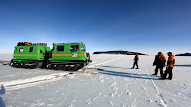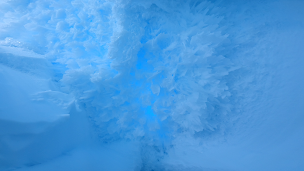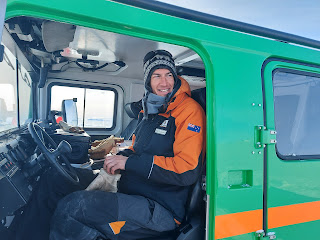Sunday: Brunch or Sightseeing?
Tough choice for a Sunday morning - whether to stay at Scott Base for a leisurely cooked breakfast, or to join the trip heading out to Cape Evans to see Scott's hut. Luckily, there was space on the sightseeing trip for five of our team to join, while the other three of us remained at Scott Base to get a few jobs done. The advantage of staying behind was being able to enjoy the famous Scott Base Sunday brunch!
With the very unusual sea ice conditions this year, it was not certain that any trips out to see the hut at Cape Evans would even be possible. But Ollie, Svenja, Jacqui, Nina, and Craig had a real treat in store for them... The weather was absolutely beautiful - a gorgeous day to be out travelling on the sea ice. The group needed to stop and profile every sizeable crack in the sea ice to assess whether crossing it and continuing on would be safe. In a couple of places, 'bridging timbers' were required to help.
An added and unexpected bonus was a trip into the ice caves of the Erebus Glacier Tongue (EGT) on the way home to Scott Base. The EGT flows down from Mt Erebus forming a narrow, scalloped snake of glacial ice that stretches out from the coast and into the waters of McMurdo Sound. When the winter comes and the surface of the ocean freezes, it forms a solid floor within the 'scallops', resulting in these beautiful ice caves. On the ceiling and walls, ice grows very slowly, resulting in huge individual crystals, some as large as the palm of a hand. In places, the ice also extends downward in sharp but beautiful ice 'stalactites' that hang precariously overhead. The wonderful and unique blue colour results from sunlight filtered through ice and snow.

Once the team were all back at Scott Base and everyone had enjoyed a nice hot meal, we took to the sea ice once again - this time to complete the 'pressure ridges walk' in the late evening sunlight. The pressure ridges form when tides force the sea ice to crash and buckle under the stress of colliding with the land forming fantastical shapes. Another advantage of this phenomenon is that it provides easy access onto the surface for seals to sunbathe and to birth their pups. At present only one pup has been born, but there will be many more to come throughout the remainder of the season.
It was such a lovely way to end the day. Thankfully, there was no wind, but nonetheless the temperatures were low enough to freeze breath onto hair, eyebrows, and nose hairs, giving everyone a rather 'frosted' appearance!












Comments
Post a Comment